In radio engineering practice, checking the voltage with a multimeter is an ordinary procedure that allows you to control its level in working circuits in the selected measurement mode. When carrying out this operation, novice radio amateurs have a number of questions regarding the procedure for working with the meter at their disposal. Ordinary users are mainly interested in how the necessary modes are selected and how to measure the voltage in the household network of a city apartment so as not to endanger their lives.
How to connect multimeter wires
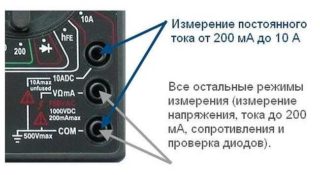
When taking measurements, it is important to understand where the multimeter probes are inserted and how to connect them correctly. It is recommended to remember the following points:
- most universal measuring instruments on their front panel have three sockets for connecting wires;
- the set includes two test leads with a set of probes, one in black and the other in red;
- the first is inserted into a socket labeled "COM" or "Common", and the second into a socket with several symbols (among them there is a voltage symbol "V");
- the third socket with a set of built-in shunts is intended for measuring high currents (up to 20 Amperes and above).
To measure voltage, only the first two sockets are used, in which the black wire always remains in place. To change the type of work (determination of capacitance or current values, for example), only a probe in red insulation is pushed over.
Difference between AC and DC voltage
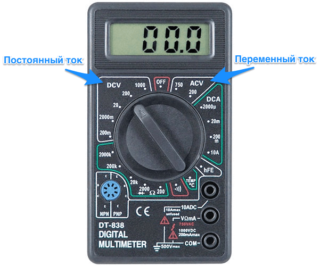
Before you measure the voltage in a car battery or outlet, it is important to understand its characteristics. According to their physical manifestations in electrical circuits, voltages are divided into constant and variable. The first type is characterized by a constant value of the amplitude and the flow of the current caused by it only in one direction. Therefore, when measuring it, the appropriate view is selected, designated on the front panel of the device as "DC".
Alternating or impulse current and the corresponding voltage are usually denoted by the symbol "AC". They are distinguished by a continuous change in the instantaneous value (amplitude) over time. In operating electrical networks, its value changes from 220 Volts to zero 50 times per second. Before measuring the AC voltage, the device must be switched to the appropriate view.
How to measure voltage in an outlet
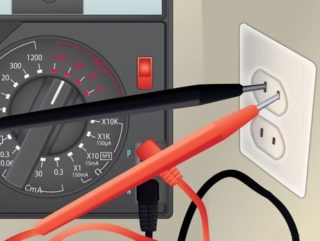
In domestic conditions, it is often necessary to check the value or absence of voltage in the outlet, which is explained by its frequent disappearances and deviations from the norm. If the user has a multimeter in his personal household, it will not be difficult to check the network. Procedure:
- The test leads are inserted into the instrument as provided for the voltage test.
- Select "AC" mode and set the desired limit to 250 or 750 Volts AC.
- The sharp ends of the test leads are inserted neatly into the receptacle sockets without regard to polarity.
- As a result, the value of the measured value is displayed on the indicator board.
When inserting the ends into the holes of the socket, do not touch their bare parts with your hand. Only hold the probes by the insulating nozzles.
The value displayed by the device usually differs from the nominal value of 220 Volts - under normal load it will be equal to 230-235 Volts. If there is no mains voltage, the device will show zero or one.
How to measure the voltage of a battery or battery
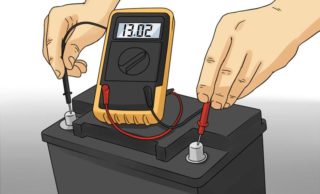
To measure the voltage in a car battery or miniature battery, it should be noted that they are DC sources. In this case, voltage measurements with a multimeter will be carried out correctly if the following conditions are observed:
- when connecting the ends of the device to the battery poles, it is important to observe the specific polarity of the connection;
- a measuring probe in red insulation is connected to the plus of the power supply, and the black one to its minus;
- to take readings on the measuring device, you will need to turn on the "DC" mode.
As in the variant with alternating voltage, in this case it is important to set the limit required according to the measurement conditions. If this rule is violated, if the measured value exceeds the set value, the multimeter stably shows "1". This means that the limit must be increased to a higher value than the value to be checked.
Possible malfunctions
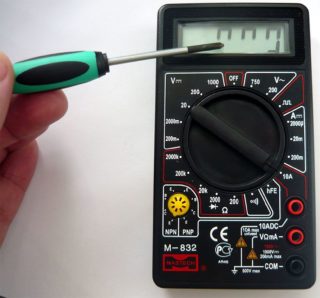
If the unit icon appears immediately after turning on the device and does not disappear, the ADC chip in it has burned out and needs to be repaired / replaced. In addition to this characteristic voltage measurement malfunction, the following malfunctions can occur:
- the tester overestimates the readings, when compared with the data of a working device, they differ by a significant amount;
- the display shows random numbers, the multimeter does not show voltage at all;
- at the upper measurement limits, the readings are greatly underestimated.
In the first case, the multimeter does not correctly measure the voltage due to the discharge of the battery installed in the supply compartment. It should be checked and, if necessary, replaced with a new one. Determining the nature of the second malfunction will help checking the ADC, which most often fails with just such a typical malfunction. The third error is highly likely due to the breakdown of one of the electrolytic capacitors, which stands out among other parts by the characteristic swelling of the case.
Is it possible to measure voltage without a multimeter
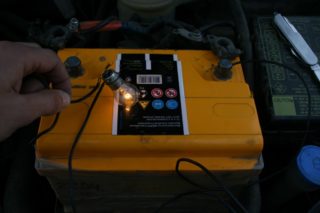
There are various ways to determine the voltage value in the absence of a device. The most difficult of them is the use of a conventional voltmeter or a modern electronic oscilloscope as a meter. However, the likelihood that these not quite simple measuring devices will end up in the user's home at the right time is very small. If they are absent, it is possible to check the voltage in the network or on the battery using the old "old-fashioned" method - by means of a light bulb at the appropriate value. With its help, you can even measure the magnitude of the voltage, but only approximately.
When checking the network, the 220 volt lamp should burn at full glow. By the brightness of its glow, it is possible to only very roughly estimate the measured value: half of the glow is approximately 120-140 volts. They act similarly when assessing the battery voltage, only in this case a 12-volt light bulb is taken.
It is possible to check miniature batteries for 4.5 or 9 Volts (KBS or "KRONA") by simultaneously touching their contacts with the tip of the tongue. It usually produces the "sour" taste that is characteristic of lemon. The stronger this feeling, the better the battery is.








